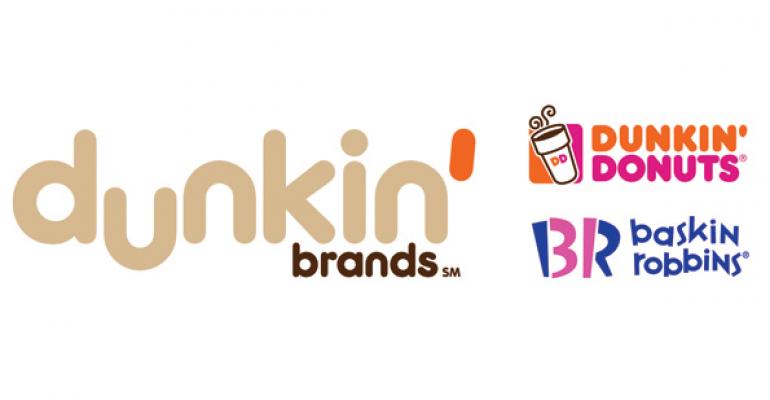Dunkin’ Donuts reported Thursday a "disappointing" same-store sales outlook for the year amid still-sluggish consumer spending and mounting competition at breakfast.
The Canton, Mass.-based chain reported a 2-percent increase in same-store sales during the third quarter ending Sept. 27. Executives suggested that Dunkin’ will struggle to meet its same-store sales targets of 2 percent to 4 percent for the full year.
Parent company Dunkin’ Brands Group Inc. reported revenue of $192.6 million, rising 3.4 percent. Net income grew 36 percent, to $54.7 million. Operating income increased 12.5 percent, to $92.5 million. The company has an operating income margin of 51.6 percent.
But investors concentrated on the quick-service chain’s disappointing sales outlook, and its stock fell by more than 6 percent in early trading Thursday.
“We faced some headwinds,” Dunkin Brands chairman and chief executive Nigel Travis said during the company’s conference call Thursday morning. “We’re disappointed with our performance relative to where we thought we’d be.”
3Q NET INCOME
 Result: $54.7 million, or 52 cents per share
Result: $54.7 million, or 52 cents per share% Increase: 36% (from $40.2 million, or 38 cents per share)
3Q REVENUE
 Result: $192.6 million
Result: $192.6 million% Increase: 3.4% (from $186.3 million)
3Q SAME-STORE SALES
 % Increase at Dunkin' Donuts U.S.: 2%
% Increase at Dunkin' Donuts U.S.: 2%
 % Increase at Baskin-Robbins U.S.: 5.8%
% Increase at Baskin-Robbins U.S.: 5.8%
The competitive environment was partly to blame. Breakfast has become a valuable daypart for restaurants, and is the only major daypart that is growing. This year, Taco Bell added a breakfast platform, and McDonald’s morning sales have improved even as its overall business has weakened. Yet Travis said Dunkin’s business is not hindered by a specific competitor.
“It’s just the sheer amount of people trying breakfast and coffee,” he said. “They’re all attracted by the growth of the segment.”
Travis said the economy is the bigger problem.
“I’m concerned about the consumer,” he said. “I really think the consumer is in a strange place.”
He said he thought lower gas prices over the past six weeks would help the consumer and provide a sales boost, but that didn’t happen.
The company hopes new product offerings will drive sales, including its recent addition of Dark Roast coffee. Twenty percent of Dunkin’s DD Perks loyalty program members bought the coffee the day it was introduced, and 30 percent of those continued to buy the product afterward, Travis said.
Despite the chain’s sales disappointment, unit development has been surprisingly strong. Franchisees developed 197 new locations during the quarter, including 120 new Dunkin’ Donuts units in the U.S. that was “greater growth than we anticipated,” Travis said.
When Dunkin’ Brands went public in 2011, executives suggested at the time that the chain’s U.S. development potential was 15,000 locations. But the surprising unit growth — much of it in core markets — led the company reason to say it could accommodate 17,000 locations in the U.S.
“We are opening restaurants at a very healthy pace,” Travis said.
Baskin-Robbins provided another bright spot for Dunkin’ Brands. The frozen-treat chain is in the midst of a turnaround in the U.S. It reported a 5.8-percent increase in same-store sales during the quarter, the sixth straight positive period for the once struggling concept. The chain also added six new U.S. units during the quarter.
Baskin-Robbins drove sales in part with an offer of a free waffle cone when customers bought a second scoop of ice cream. It also increased online orders of cake by reducing the minimum advance notice for an order from 48 hours to 24 hours.
“We continue to be very happy with the turnaround of this brand,” Travis said.
Contact Jonathan Maze at [email protected].
Follow him on Twitter: @jonathanmaze

